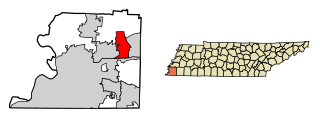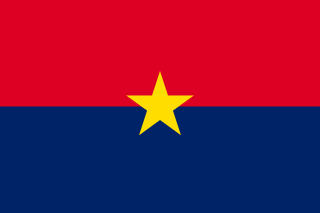
Lakeland is a city in Shelby County, Tennessee, and a suburb of Memphis. The population was 12,430 at the 2010 census.

Chiang Wei-kuo was an adopted son of Republic of China President Chiang Kai-shek, adoptive brother of President Chiang Ching-kuo, retired Army general, and an important figure in the Kuomintang. His courtesy names were Jian'gao (建鎬) and Niantang (念堂).

Guomao is an area in Beijing at the center of the Beijing central business district, demarcated by the intersection of Jianguomen Outer Street and the Third Ring Road. The Chinese World Trade Center is located there. It was formerly known as Dabeiyao, and bus stops in the vicinity still bear this name.
Gao Xianzhi, or Go Seonji, was a Tang dynasty general of Goguryeo descent. He was known as a great commander during his lifetime. He is most well known for taking part in multiple military expeditions to conquer the Western Regions, over the Pamir Mountains, and reaching the Aral Sea and the Caspian Sea. In 751 he commanded the Tang forces during the Battle of Talas, fighting against the Abbasid Caliphate. The Tang defeat at the Talas River is considered to mark the end of both Tang western expansion and Abbasid eastern expansion.

Daliao District (Chinese: 大寮區; pinyin: Dàliáo Qū; Wade–Giles: Ta4-liao2 Ch'ü1) is a suburban district in Kaohsiung City, Taiwan. Conurbated with Kaohsiung, it has 111,675 inhabitants in 2016. It is linked with Kaohsiung Downtown by the Orange Line of the KMRT.

Hailun is a city in west-central Heilongjiang province, People's Republic of China. Administratively, it is a county-level city under Suihua City.

The Fujian People's Government is the common name for the People's Revolutionary Government of the Republic of China (1933–1934), also known as the Fujian People's Government, was a short-lived anti-Kuomintang government in the Chinese Republic's Fujian Province. The rebellion that led to its formation and its collapse are known as the Fujian Incident or Fujian Rebellion.

Dashu District (Chinese: 大樹區; pinyin: Dàshù Qū; Wade–Giles: Ta4-shu4 Ch'ü1; Pe̍h-ōe-jī: Toā-chhiū-khu) is a suburban district located in Kaohsiung City, Taiwan and shoring Kaoping River. Fo Guang Shan is one of largest travelling spot in Dashu District. It is also the base of E-Da World, a new lifestyle destination that encompasses the upscale Crowne Plaza Kaohsiung E-Da World hotel, the E-Da Skylark hotel, the E-DA Theme Park, the E-Da Mall, E-Da City (Real Estate Development) and I-Shou University.
The 113th Mechanized Infantry Division, now the 113th Medium Combined Arms Brigade, is a military formation of the People's Liberation Army of the People's Republic of China.

Shan King (South) is an at-grade MTR Light Rail stop located at Shan King Shopping Centre, Shan King Estate, in Tuen Mun District, Hong Kong. It began service on 24 September 1988 and belongs to Zone 2. It serves the south of Shan King Estate.
The Cantons of Bourges City are 4 cantons situated in the Cher département and in the Centre-Val de Loire region of France. Each canton covers a part of the commune of Bourges.
The Battle of Shuangqiaozhen was fought from March 6 to March 12, 1931 between the 34th Division of the Army of the Kuomintang Nationalist Government and the Red Army of the Communist Party of China. The commander of the 34th Division, Major General Yue was captured by the communists. In August 1932, Yue was executed by firing squad on the orders of Zhang Guotao and posthumously promoted to full general.
The Second Battle of Guangzhou was fought between the rival armies of the Liangguang region in Southern China as part of the internal conflicts within the Kuomintang leading up to the Central Plains War. The previous month, the New Guangxi clique had fought the Sichuan clique at the Battle of Yichang in Hubei. The forces of the New Guangxi clique attacked Guangzhou from both their home province of Guangxi as well as Jiangxi. Guangdong forces captured a brigade commander of the New Guangxi clique's army.
The Battle of Guangzhou was an internal conflict within the National Revolutionary Army in the aftermath of Chiang Kai-shek's successes in the Northern Expedition. It occurred shortly after the Communist Party of China-led Guangzhou Uprising, which was crushed by Li Jishen's opponent Zhang Fakui. On December 28, 1927, Li Jishen's forces were able to capture Guangzhou, and Miao Peinan retreated to Huizhou. On December 29, 1927, local leader Li Fulin, an opponent of Li Jishen, was removed from office and replaced with Deng Yanhua.
The Battle of Eastern Henan was between the Central Army of Chiang Kai-shek and those of Sun Dianying, a Henan native and ally of Feng Yuxiang and Yan Xishan. Sun's forces attacked the Longhai railway line, a stronghold on the eastern provincial border of Henan. The railway linked the cities of Kaifeng, Zhengzhou and Luoyang.
The Battle of Guanghua was fought between the National Revolutionary Army of Chiang Kai-shek and the Guominjun of Feng Yuxiang. Both sides were part of the Kuomintang.

The 715 Incident, known by the Communist Party of China (CPC) as the 715 counter-revolutionary coup, and as the Wuhan–Communist split by the Kuomintang (KMT), occurred on 15 July 1927. Following growing strains in the coalition between the KMT government in Wuhan and the CPC, and under pressure from the rival nationalist government led by Chiang Kai-shek in Nanjing, Wuhan leader Wang Jingwei ordered a purge of communists from his government in July 1927.

The Wuhan nationalist government, also known as the Wuhan government, Wuhan regime, or Hankow government, was a left-wing nationalist government of China led first by Eugene Chen, and later by Wang Jingwei, that was based in Wuhan from 5 December 1926 to 21 September 1927. Following the capture of Wuhan during the Northern Expedition, the existing Kuomintang (KMT) government, which had been based in Guangzhou, moved there in December 1926. In April 1927, after National Revolutionary Army (NRA) commander-in-chief Chiang Kai-shek purged communists and leftists in the "Shanghai massacre", the Wuhan government split from Chiang in what is known as the "Nanjing–Wuhan split". Chiang subsequently formed his own government in Nanjing. While Chiang continued the Northern Expedition on his own, increasing tensions between communists and the KMT in the Wuhan government resulted in a new purge of communists from that government, and an eventual reconciliation with the Nanjing faction, after which the government moved to Nanjing.
The northern Henan battle took place on May 27, 1929, and the location was in northern Henan, China. It was one of the civil war battles that took place inside the National Revolutionary Army. The two warring sides of the division were Han Fuju Army supported by Chiang Kaishek and Pang Bingxun Army supported by Feng Yuxiang. Han was a former subordinate of Feng while Pang had once been a commander of the Zhili clique's Wu Peifu before joining Feng.